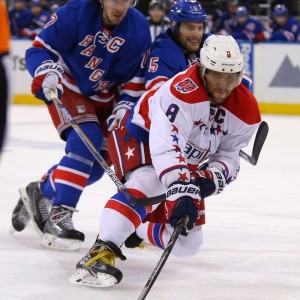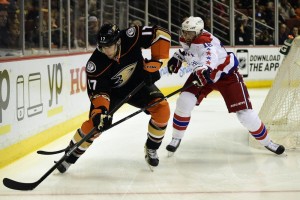In the NHL, there is no doubt that there has been a statistical revolution – widely available league data, access to the internet and computer programs have allowed people to crunch all sorts of data about hockey and today, it seems reasonable to think, hockey fans are more knowledgeable than ever before.
Still, some ideas about the game are so hard-wired that even though they are considered by many to be all but obsolete, they continue to permeate not only discussion among fans, but also TV broadcasts and even the decision making of some NHL teams.
Here then are Three Myths about the NHL that I believe can easily be debunked.
1. Plus/Minus Is an Important Statistic
It’s not important or meaningful at all. There are many factors which make plus/minus a completely useless stat.
I have written about this before, so here is a re-written and tightened up version of what I posted about the stat in an article I wrote defending Ovechkin’s -35 season:
To understand the problem with plus/minus, you must first understand why shots are a much better way of evaluating a player than goals scored.
In the NHL, goalies save roughly 89-92% of shots. An .890 save % is brutal, while a .930% is Vezina-worthy, and thus the range is very small – literally, the difference between being out of the league and being an above replacement-level goalie is allowing three or four less goals over a hundred shots – or roughly one goal per game. Therefore, if a player is on the ice a lot and your goalie is only playing marginally worse than average, his plus/minus can be severely impacted through no fault of his own.
But the fact that so few shots actually end up in the back of the net also means that plus/minus, by using goals as it’s measurement, is always going to be based on a small sample size and thus increasing the chances that any conclusion drawn from it is wrong by a drastic amount. No one says shots can tell you everything, but since there’s roughly a ratio of 90:10 shots to goals, you get a larger sample and less error if you use shots.

To further understand how ineffective and inaccurate player evaluations based on plus/minus are, you have to understand the way goals are scored: great plays don’t always result in goals and bad plays sometimes do. A player can make an amazing play, a goalie can flub a shot or anything in between – how the goal goes in is actually pretty random, which means that the way to score goals is not as important as just putting shots on net. The more volume you produce (since, over time, all shots could be averaged out to X difficulty) the more goals you will score. But because of that randomness, goals are actually a terrible way to evaluate a player, and since plus/minus is based on goals, it is not a helpful stat.
Understanding this goes a long way in realizing why plus/minus is a bad stat: it is based on goals, which are essentially a function of luck – the skill is getting the shots off, whether they go in or not isn’t really something you can do anything about at the NHL level. A much better plus/minus stat would use shots or shot-attempts as the metric instead of goals (i.e Corsi or Fenwick) because making judgments or evaluations on random results is – if you think about it – not something you would ever intentionally do.
Factor in usage (a player tasked with playing against the opposition’s best players is more likely to be scored on), both goalies (you can get a “plus” if the other team’s goalie is cold and a “minus” you don’t deserve if yours is), teammates (plus/minus is distributed equally,so you can get a “minus” from an ill-timed line-change or a teammate’s error), ice time (the more you play, the more you’ll be scored on), and team quality (bad teams allow more goals) and you should start to get a picture of how little plus/minus adequately measures.
There is also an interesting study done (linked here) that showed that when awarding a “minus,” over half the players who received one had “little to no impact” on the goal being scored.”
The conclusion is rather obvious: plus/minus is a stat based off of another already misleading stat (goals) and therefore can’t be trusted. In the future, no one should ever bring up plus/minus or mention at all.

2. Faceoffs Are Important
You always hear somebody say “yeah, but he’s good at faceoffs,” like this is a skill that is important in comparison to skating, shooting, scoring, passing or defense. It isn’t.
This isn’t to say that occasionally there are not very important faceoffs in hockey games, but those are actually quite rare.
A one goal lead, late in the game, is about the only time a faceoff is going to be super-important. Let’s say there are five of those per game (and I think that is way too many) but lets say that. Now we know there are usually close to 60 faceoffs per game, so less than 10% of faceoffs are qualify as super-important.
And those are just for one-goal games.
Goals scored directly off faceoffs are also quite rare, accounting for about one goal in 120 according to the article linked here. Even for the best offensive team in the league, that’s only maybe two or three per season.
One study suggests that you must win 76 more faceoffs than your opponent to equal a goal differential, and that every goal differential accounts for about a third of a point in the standings.
The study goes on to show that in 2010 when faceoff specialist David Steckel put up a 63% win rating on faceoffs, that he was worth 2.68 goals to his team, meaning that, over 82 games, the best faceoff player in the NHL was able to account for not even one point in the standings.
This would be why there are few, if any, faceoff “specialists” in the league anymore – the math just makes them obsolete. If you can’t be good at other things, being good at faceoffs is not enough of a reason to get ice-time.
Now, this isn’t to say that faceoffs are not important at all, just that their importance is overblown. There is also no correlation to winning and team faceoff percentages. There isn’t even correlation between winning faceoffs and killing penalties! Finally, the best team in the league usually wins about 55% of their draws, which means that you only win three or four more than your opponent over the course of the average game.
In the end, we shouldn’t be citing a players faceoff skills as a reason why he’s an effective player and we should make less of a deal about draws overall. They matter only a little, not as much as TV would have you believe.
3. Players Are At Their Best Around Ages 27-30
Another great myth of the NHL is that players hit their prime just before they turn thirty. In reality, they are usually long past their peak performance by that time.
According to this oft-cited study, players hit their peak points-per-minute at 24 and their peak points-per-game at 25. Though “Prime” does extend roughly to about the age of 29.

This is interesting because we tend to think that a player at 24 is still young and has a good chance of improving. On average, this is not the case. However, players age differently and there will always be anomalies. Still, it’s interesting because when you see the Leafs trade Kessel, most everyone says “now he’s with Crosby, he’s gonna score 50.” But, is that true? Knowing that the odds are great that he has already been the best he’s ever going to be, do we have to temper our expectations on just what he can do now that he has a great centre? (Don’t forget also, that his line will be expected to contribute something to defense as well).
Then there is the recent Ryan Kesler contract which will pay him nearly $7 million from ages 31-37. It already has been four years since he hit 50 points and by the time he the contract even kicks in, he’ll be seven years removed from age 24. Yet, if you go by the old-school thinking that players peak around 30, the contract doesn’t seem as bad. It seems even NHL teams are caught in the trap of believing things that are repeated so often they seem true.
I think with the salary cap becoming the biggest factor in team building and management, realizing when players accurately hit their peak and managing your team around that factor is an important thing for team to consider if they want their cap-management to give them an edge over the competition.
Hopefully, this post will spawn some discussion and maybe even convince people to stop citing these things as facts. One can only hope!
Thanks for reading.